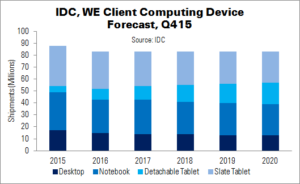Detachable tablet demand will drive the European PC and tablet market in the near future, says IDC. Detachable and slate tablet shipments will have a 51% share of the overall client computing (PC and tablet) market by 2018, up from 45% in 2015. By 2020, detachables will represent more than 20% of the client computing market, compared to 5% in 2015.
Detachables will outperform slates – which are expected to shrink over the forecast period – to 2020, with a 30% CAGR. Growth will be boosted by rising competition from new players. Most of the new designs will run Windows 10 and be based on new processors, said IDC research manager Marta Fiorentini. Both consumers and professional users will be targeted by these features. Fiorentini noted, “We are already seeing adoption gaining traction among more senior and mobile workforce ranks in some European companies and we expect this trend to accelerate as companies upgrade to Windows 10.”
Slates are showing signs of growing saturation in most Western European countries. Demand has shrunk gradually over the last couple of years; a move that is not expected to reverse. The market has become increasingly dependent on renewals, but the emergence of phablets and new consumer categories, such as wearables, are increasing the lifespan of slate tablets.
PCs, too, are mainly driven by replacements in Western Europe. Demand for notebook and desktop PCs is forecast to be soft, following strong renewals in 2014 and a significant contraction in 2015. IDC expects notebooks to stabilise from 2018, and desktops to see another renewal phase at the same time, as well as the end of Windows 7 support in 2020.
Windows 10, as we have reported previously, will not lead to major hardware refreshes but will reinforce mobility. This will lead to further detachable, convertible and ultraslim adoption. In the PC category, IDC projects AIO, convertible and ultraslim notebooks to outperform the market. These devices will represent 47.1% of all PC shipments by 2020, up from 29.5% in 2015.

